Step into the Praetorium's halls to uncover how this ancient structure shapes our understanding of Biblical narratives and Roman power.
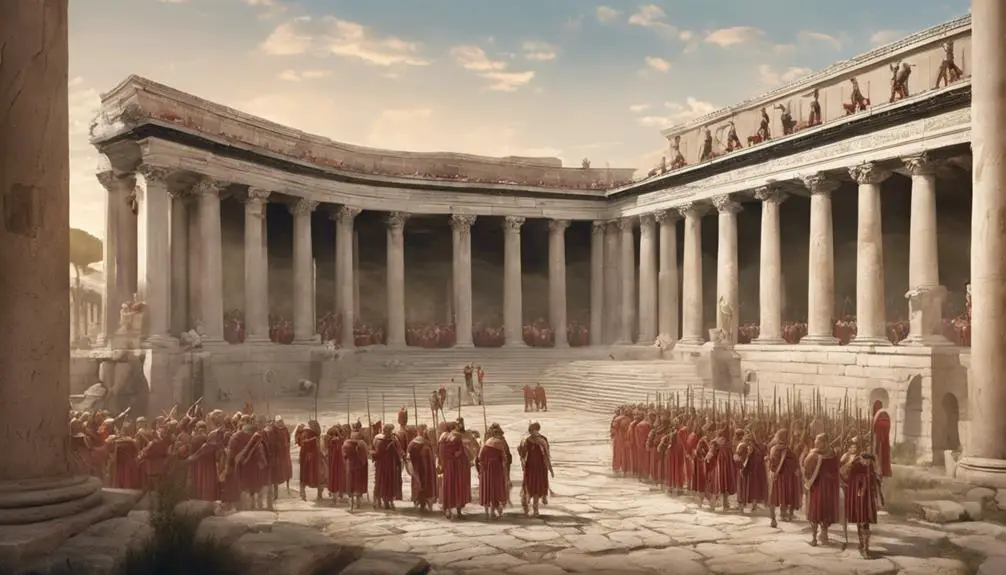
Praetorium in the Bible
You might think the term 'Praetorium' is just another historical detail in the Biblical narrative, but it's far more significant than you'd initially believe.
This isn't just about ancient architecture; it's a window into the political and theological underpinnings of the New Testament. Understanding the Praetorium's role offers insights into the complex interactions between Roman authority and early Christian thought.
As you explore this topic, you'll uncover how these insights not only illuminate aspects of Christian theology but also provide a deeper understanding of the socio-political landscape of the time.
Now, why should you care about this ancient structure? Well, its implications reach far beyond bricks and mortar.
Key Takeaways
- The Praetorium was the site of Pilate's judgment and condemnation of Jesus, pivotal in the New Testament.
- It symbolizes the intersection of Roman authority and Jewish culture, highlighting the political and religious tensions of the era.
- As a representation of Roman judicial power, the Praetorium plays a crucial role in Christian theology as the place of Jesus' sentencing.
- Its architectural and administrative significance reflects the Roman Empire's dominance and influence on historical events described in the Bible.
Historical Background of Praetorium
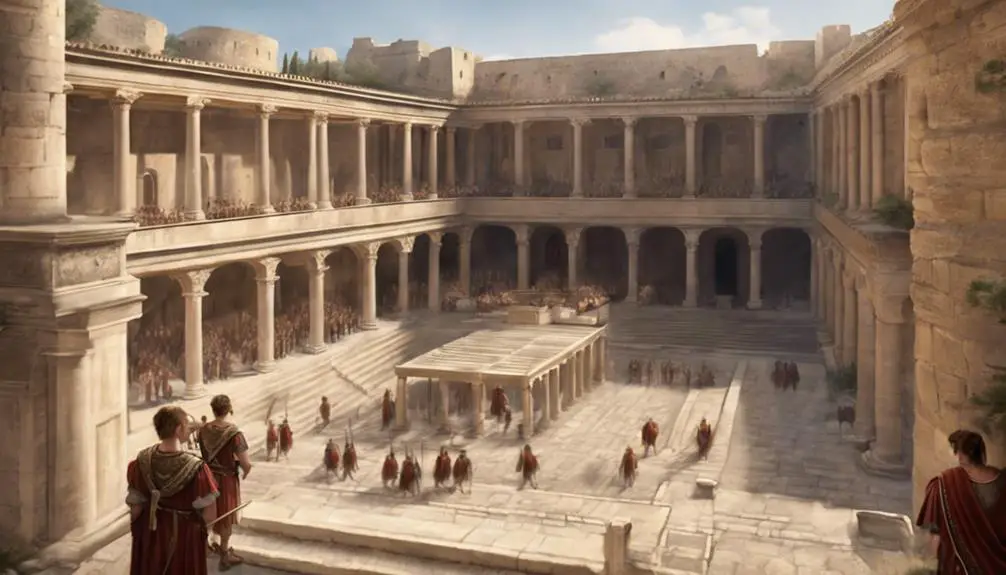
The term 'Praetorium' originally referred to the general's tent within a Roman military camp, serving as both a command center and a living space, a concept that evolved significantly by the time of the New Testament. Initially, its role in Roman governance was deeply intertwined with military strategy, embodying the nexus of power and command within the expansive territories under Roman control. As you delve deeper, you'll understand that the Praetorium wasn't just a tent but a symbol of Roman authority, a mobile hub that orchestrated military campaigns, legal decrees, and administrative duties.
The evolution of the Praetorium reflects the shifting dynamics of Roman military and political strategies. From a practical standpoint, it facilitated rapid decision-making and efficient command of troops, crucial for maintaining Roman dominance. However, its significance extended beyond the battlefield. As Roman governance became more sophisticated, the Praetorium transformed, mirroring the complexities of the empire's administrative and judicial functions. This adaptability underscores the Roman Empire's capacity to integrate military prowess with administrative acumen, a balance that was pivotal in sustaining its vast territories and diverse populations.
Praetorium in New Testament Narratives
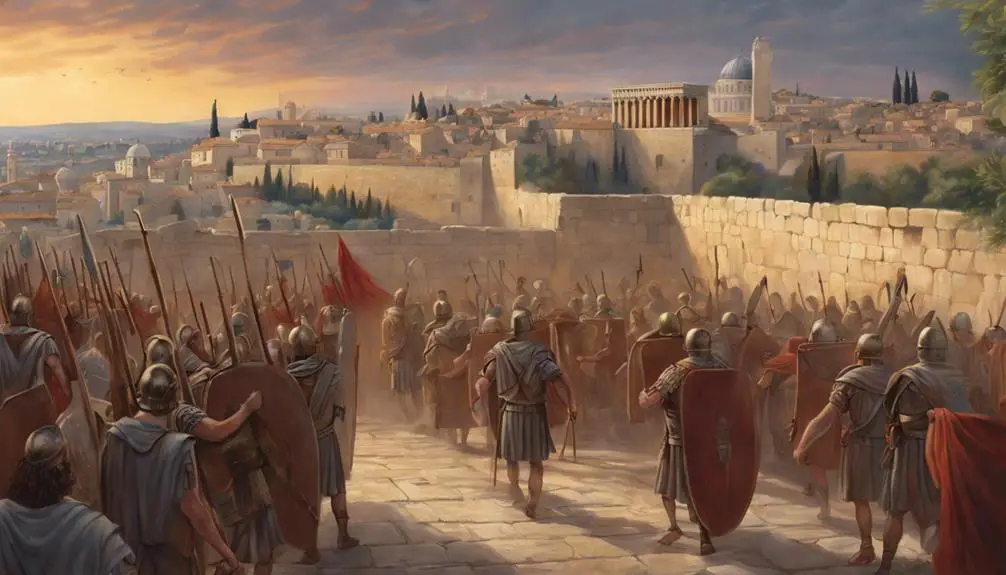
Understanding the evolution of the Praetorium provides crucial context for its appearances in New Testament narratives, where it assumes a pivotal role in the events leading to the crucifixion of Jesus. Here, the Praetorium is more than a backdrop; it's a stage where critical decisions and trial proceedings unfold, deeply impacting the course of biblical history.
- Pilate's decision: The Praetorium serves as the setting for Pilate's judgment and eventual condemnation of Jesus, highlighting the political and judicial power wielded within its walls.
- Trial proceedings: This location underscores the formal and legalistic aspects of Jesus' trial, revealing the complexities of Roman and Jewish interactions.
- Symbol of authority: The Praetorium, as the governor's residence, represents Roman authority and its clash with the Jewish populace, reflecting broader themes of power and justice.
- Cultural intersection: It's a focal point for the collision of cultures, ideologies, and religions, illustrating the tension between Roman rule and Jewish expectations.
In its New Testament appearances, the Praetorium isn't merely a place but a potent symbol of authority, justice, and the pivotal moments leading to the crucifixion of Jesus, inviting a deeper reflection on its historical and theological significance.
Architectural Insights Into Praetorium
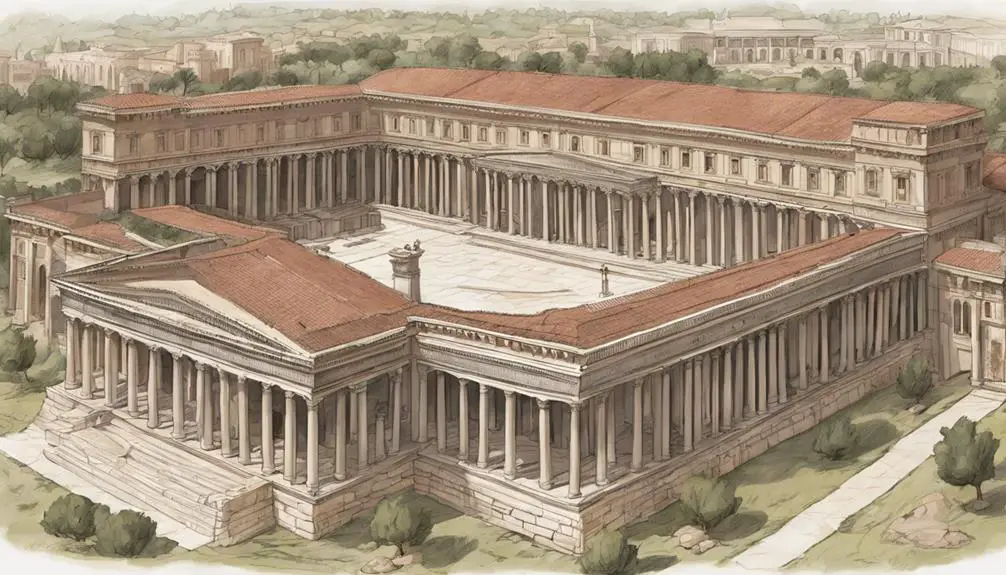
Exploring the architectural features of the Praetorium reveals its significance not only as a political and judicial hub but also as a testament to Roman engineering and cultural influence. You'll find that Roman influence is evident in the choice of construction materials and the engineering techniques employed. The Romans were renowned for their use of concrete and stone, materials that ensured the longevity and durability of their structures. In the Praetorium, these materials were likely utilized to convey a sense of permanence and authority.
Additionally, the architectural layout of the Praetorium would have been designed to accommodate its multifunctional role. Spacious courtyards, grand halls, and private chambers suggest a complex that wasn't only meant for public judicial proceedings but also for administrative purposes. The strategic placement of the Praetorium within a city or military camp underscores its importance in Roman governance, serving as a clear marker of Roman architectural and political dominance in occupied territories.
The use of arches, columns, and intricate mosaics within the Praetorium would have further demonstrated Roman aesthetic preferences and engineering prowess, blending functionality with artistry. This architectural sophistication highlights how the Praetorium was more than a building; it was a symbol of Roman civilization's far-reaching influence.
Political Significance of Praetorium
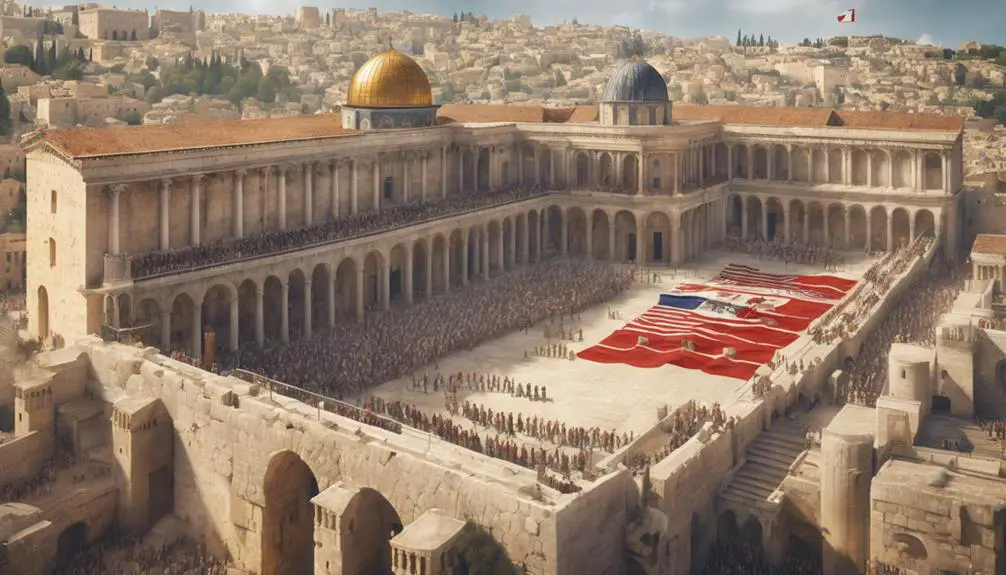
Beyond its architectural grandeur, a Praetorium held deep political significance, serving as a nerve center for Roman administrative and judicial authority in occupied territories. This wasn't just a lavish residence for governors; it was a concrete manifestation of Roman governance, a symbol of their far-reaching control and sophisticated military strategy. The presence of a Praetorium in a region wasn't merely about providing luxurious accommodations for Roman officials; it was about displaying the might and reach of the Roman Empire, underscoring a message of dominance and order.
- Symbol of Roman Authority: The Praetorium embodied the administrative and judicial power of Rome, reinforcing the empire's control over newly conquered lands.
- Center for Military Strategy: It served as a crucial hub for planning military operations, ensuring the security and expansion of Roman territories.
- Administrative Hub: The Praetorium was where crucial decisions affecting the lives of local populations were made, from taxation to legal judgments.
- Cultural Integration: By imposing Roman architectural and administrative practices, the Praetorium played a role in the assimilation of local cultures into the Roman way of life.
In essence, the Praetorium was much more than a structure; it was a potent tool in the machinery of Roman governance and military strategy.
Praetorium's Role in Christian Theology
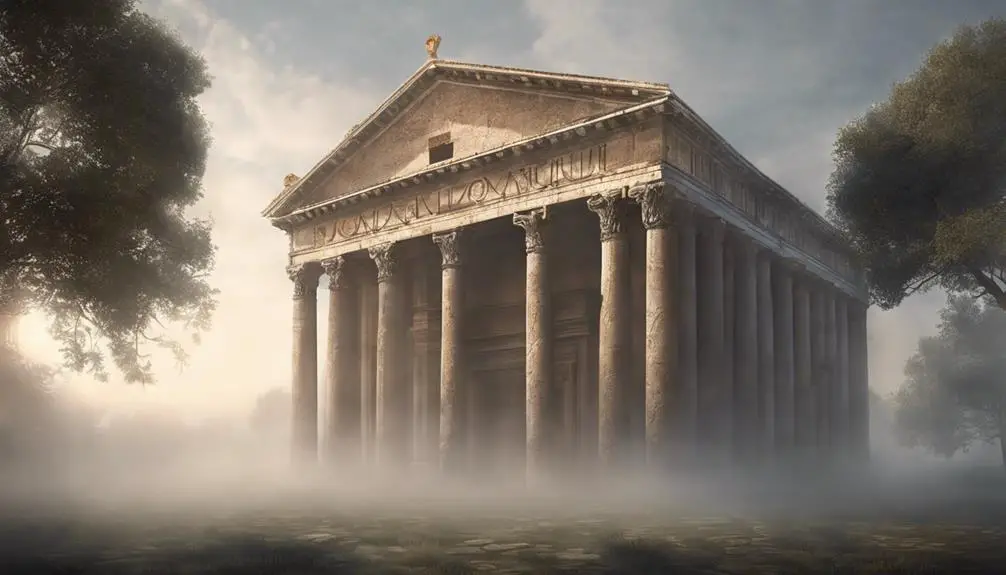
In Christian theology, the Praetorium holds profound symbolic significance, representing the judicial power and authority that condemned Jesus Christ, shaping the narrative of salvation and redemption. This setting, where Jesus faced Pilate and ultimately the sentence that led to the crucifixion, is deeply embedded in the Christian consciousness. It serves as a reminder of the injustice Jesus endured and underscores the sacrificial nature of his death for humanity's sins.
The mention of the Praetorium in liturgy practices serves as a constant reminder to the faithful of the humility and suffering Jesus embraced for their sake. This aspect of liturgy not only commemorates Jesus's path to crucifixion but also invites believers to reflect on their own spiritual journey and the sacrifices required for faith and redemption.
Moreover, the ethical implications of the events that transpired in the Praetorium challenge Christians to consider issues of justice, power, and the moral courage to stand for truth in the face of adversity. It prompts a deeper contemplation on how one's faith informs actions and decisions in a world still fraught with moral dilemmas and injustices, mirroring the complex interplay of power and righteousness witnessed in the Praetorium.
Frequently Asked Questions
How Do Archaeological Findings of Praetorium Sites Compare With Biblical Descriptions in Terms of Accuracy and Detail?
When you explore how archaeological findings of praetorium sites match up with historical records, it's fascinating. Modern excavations and praetorium reconstructions have shed light on their accuracy and detail, offering a unique glimpse into the past.
These findings often confirm historical descriptions, but discrepancies can arise due to interpretations or the condition of remains. It's a testament to the meticulous work of archaeologists and historians in piecing together history's puzzle.
Has the Concept or Function of the Praetorium Evolved in Modern Religious or Historical Contexts Outside of Its Biblical Significance?
You've probably noticed that the concept of the praetorium has indeed evolved beyond its original significance.
In modern adaptations, this term captures a broader cultural significance, reflecting its historical roots while adapting to contemporary contexts.
Whether in literature, architecture, or religious discourse, its function and symbolism have been reinterpreted, aligning with current values and narratives.
This evolution showcases how historical concepts can remain relevant by adapting to modern perspectives and uses.
Are There Any Notable Artistic Representations of the Praetorium Throughout History, and How Have They Influenced Public Perception of Biblical Events?
You've likely seen various artistic representations of historical events, which often include depictions of significant locations. These portrayals, rendered in diverse artistic styles, have been showcased in public exhibitions, shaping how you perceive past events.
Through these visual narratives, artists have influenced your understanding of history, suggesting a profound connection between art and historical interpretation. This is especially true for portrayals of notable places, capturing their essence and importance throughout time.
How Has the Interpretation of the Term 'Praetorium' Differed Among Various Biblical Translations and Scholarly Works, and What Are the Implications of These Differences?
You'll find that the term 'praetorium' has seen varied interpretations across biblical translations and scholarly works. Its origin and military usage have shaped these differences, influencing how historical and religious contexts are understood.
These variations have significant implications, as they affect our perception of key events and locations. By examining the term's evolution, you gain insight into how linguistic shifts can alter our comprehension of historical narratives.
Can Parallels Be Drawn Between the Judicial Processes That Took Place in the Praetorium and Those in Contemporary Legal Systems, Considering Cultural and Historical Differences?
You can draw parallels between judicial processes in historical settings and contemporary legal systems by examining legal reforms and cultural influences. Despite the vast differences in time and culture, the fundamental principles of justice and the administration of law show continuity.
Analyzing these parallels helps you understand how legal practices evolve and adapt, reflecting societal values and norms. It's a fascinating study of how history informs the present in the realm of law and governance.
Conclusion
In conclusion, the praetorium holds a multifaceted role within the Scriptures and early Christian thought. You've seen it as not just a physical location of political power and judicial authority, but also a significant setting in the New Testament, particularly in the Passion narratives. Its architectural and political significance deepen our understanding of the biblical events that unfolded within its walls.
Thus, the praetorium's presence in Christian theology can't be overstated, embodying both historical reality and profound symbolic resonance.



Sign up